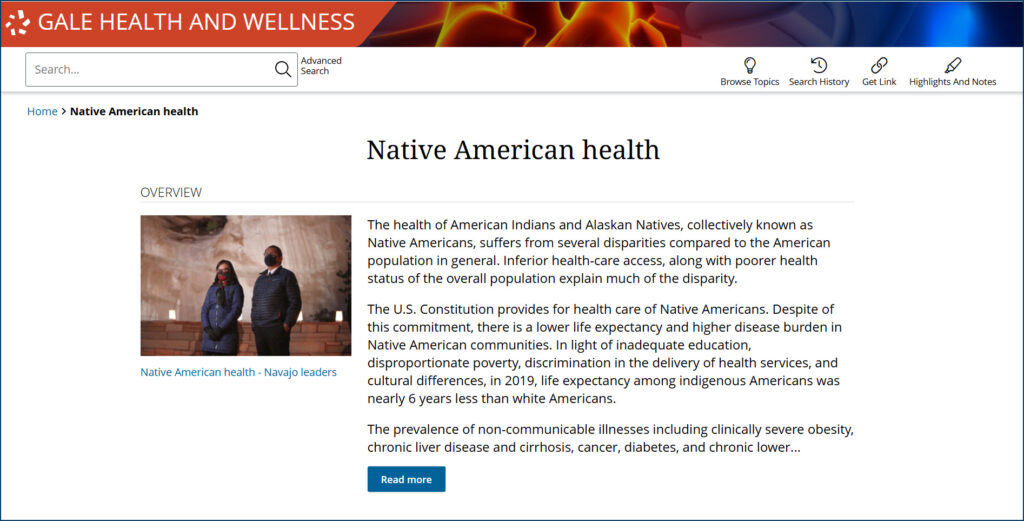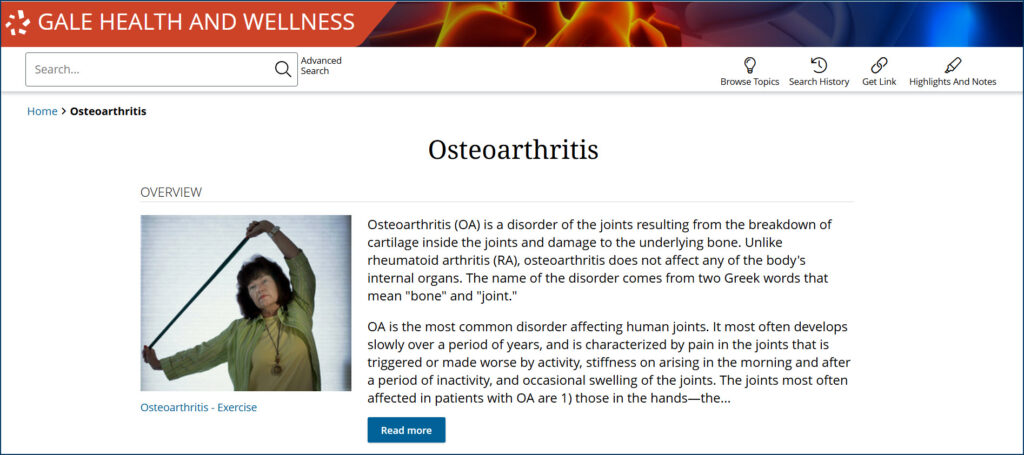| By Gale Staff |
Every student in the healthcare field anticipates the moment they meet with a patient for the first time—when they must take all their medical knowledge and training and transform it into something more than the sum of its parts: an outcomes-driven conversation.
Successful patient interactions require more than an understanding of the science. It’s about asking the right questions, communicating key information—and listening to the real people who walk through their clinic doors.
So, how can these future medical professionals prepare to see health from a patient’s perspective before setting foot in an exam room?
That’s precisely the goal of the Gale Health and Wellness database, a collection of over 11.5 million articles sourced from full-text medical journals, popular news sites, and reference works covering 395 topics related to diseases, disorders, diagnostics, and treatments. Unlike healthcare databases traditionally used in academic settings, however, Gale’s was designed as a public health tool. By featuring the topics users are most interested in, students can start to anticipate the questions and concerns they may encounter in real-world patient interactions.
We have organized the Gale Health and Wellness database into six key areas that simplify medical topics into overarching categories:
- Therapies, Treatments, and Surgeries: Presents content on various treatment options, including alternatives to Western medicine, so students can discuss modern and holistic medicine according to patient needs.
- Diseases and Conditions: This section supplies up-to-date information on medical conditions to assist practitioners in informing patients about diagnoses and related symptoms.
- Diagnostics and Tests: Guides users through various diagnostic tools, supporting medical professionals in explaining these tests’ purposes.
- Community Health: Prepares future healthcare workers to understand and address the unique health challenges of different populations, enabling more culturally aware care.
- Mental Health: Provides insight into mental health conditions and treatments so practitioners can address comorbidities with greater empathy.
- Drugs: Offers details on medications, side effects, and interactions to assist with evaluating complementary treatments.
To see how this might work in practice, let’s look at how students can use these topic portals to access a comprehensive collection of consumer health resources.
Culturally Competent Care in Native American Communities
By accessing Gale’s Community Health category, students can explore various demographics-based approaches to healthcare, including topics that impact Native American health services.
Indigenous communities experience disproportionately high rates of non-communicable conditions like diabetes, liver disease, respiratory issues, mental health challenges, and substance abuse. These health inequities are rooted in historical forces, including colonization and forced assimilation.
Only by understanding the historical trauma many Native patients carry can non-Indigenous healthcare workers begin to appreciate why many are hesitant to engage with healthcare services.
Students can explore the Native American Health topic page, which includes more than 1,200 articles, journals, reference documents, and multimedia resources to provide insight into common health conditions and the broader cultural context in which care is sought—or, possibly, avoided.
Equipped with this knowledge, students can then turn to Gale’s Culturally Competent Care topic page for information about respectfully applying it across every patient interaction. This means being attuned to how we can adapt patient care, including respecting Indigenous medicines and considering them when developing a treatment plan.
Healthcare providers must also avoid projecting their own expectations onto any group of patients, thereby reducing complex groups into a homogenous whole. Everyone who walks into a medical office carries personal experiences, cultural values, and individual preferences that should guide the care they receive.
Examples of these potential interactions may include asking patients for their preferred names, acknowledging that past experiences with different healthcare providers might have been less than ideal, and offering to incorporate traditional medicine into their treatment plan.
In a healthcare system that has historically failed Native communities, showing this level of respect for each patient’s cultural background can start to engender trust and build rapport between healthcare providers and their Indigenous patients.
Accounting for Health Trends in the Age of Social Media
Internet access has facilitated a phenomenon in which patients are increasingly exposed to a flood of healthcare advice. Social media platforms and blogs allow for the widespread, informal sharing of information that leaves patients vulnerable to influence by incomplete, inaccurate, or misleading sources.
To that end, let’s examine how Gale Health and Wellness can help future healthcare providers better understand the ways that popular supplements are discussed in both professional and consumer contexts.
Turn to the Drugs category for insights into health trends through daily updates from trusted consumer health publications, news sources, and academic journals. Simply checking the portal’s “Topics of Interest” feature on the main page provides direct information on what patients are currently interested in. Alternatively, should they have a specific subject in mind, students can turn to Gale’s comprehensive search features to find the most relevant reference materials on alternative treatments.
For example, there has been a growing interest in holistic and plant-based treatments among the general population. While traditional usage is informed by shared cultural knowledge, that’s not necessarily the case for this more modern rise in popularity.
Instead, information is often likely to come from influencers enthusiastic about promoting health trends to their social media followers. However, their guidance isn’t always grounded in accurate medical advice. This disconnect can lead to the widespread sharing of incomplete or misleading information, which may put patients at risk if they take an herbal supplement without medical guidance.
Take turmeric, for example. The spice has a centuries-old history in Ayurvedic and traditional Chinese medicine. It has become increasingly prevalent in Western naturopathic practices, particularly for managing inflammation and pain with conditions like osteoarthritis. Empirical evidence suggests that curcumin—turmeric’s active compound—is effective in reducing inflammation and pain. However, the most recent news about the supplement points out that those taking high or concentrated doses are winding up in the hospital due to liver toxicity.
When a patient asks about turmeric’s benefits, practitioners should be able to acknowledge that it might be helpful as a supplement to clinical treatments. Still, it’s not wholly benign in every case. While turmeric has long been used to manage inflammation, it’s also important to monitor intake—particularly in concentrated forms, which can cause liver issues.
If a practitioner dismisses or discredits a patient’s questions, the patient might feel alienated from participating in their care plan. This alienation can result in the patient relying more heavily on non-professional sources of information they were already inclined to trust.
Alternatively, taking the time to acknowledge the patient’s perspective with a thoughtful conversation encourages follow-through on healthcare advice because the patient feels like the practitioner is a partner in their health rather than a dissenting party.
Gale Health and Wellness as a Tool for Building Patient-Practitioner Trust
In her book What Doctors Feel: How Emotions Affect the Practice of Medicine, Dr. Danielle Ofri shares, “Empathy requires being attuned to the patient’s perspective and understanding how the illness is woven into this particular person’s life. Last—and this is where doctors often stumble—empathy requires being able to communicate all of this to the patient.”
Gale Health and Wellness sits at the crossroads where medical knowledge and human empathy meet. By engaging with these resources, students will feel far more confident in approaching patient conversations with an empathy that encourages positive health outcomes.
For information about Gale Health and Wellness for your nursing, physiology, sports science, and other applied health programs, reach out for a free trial today.



